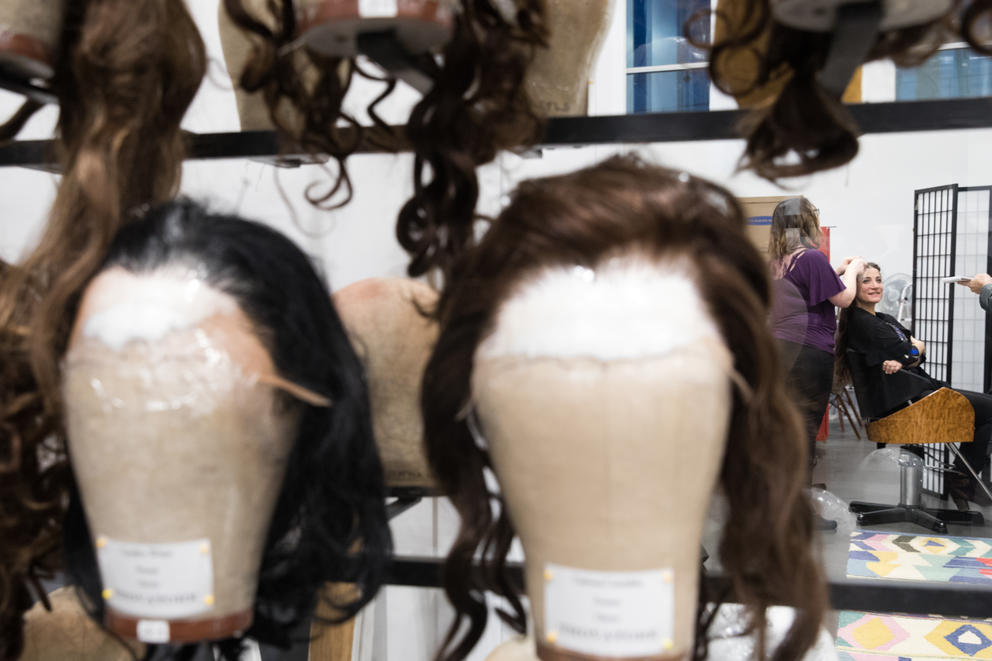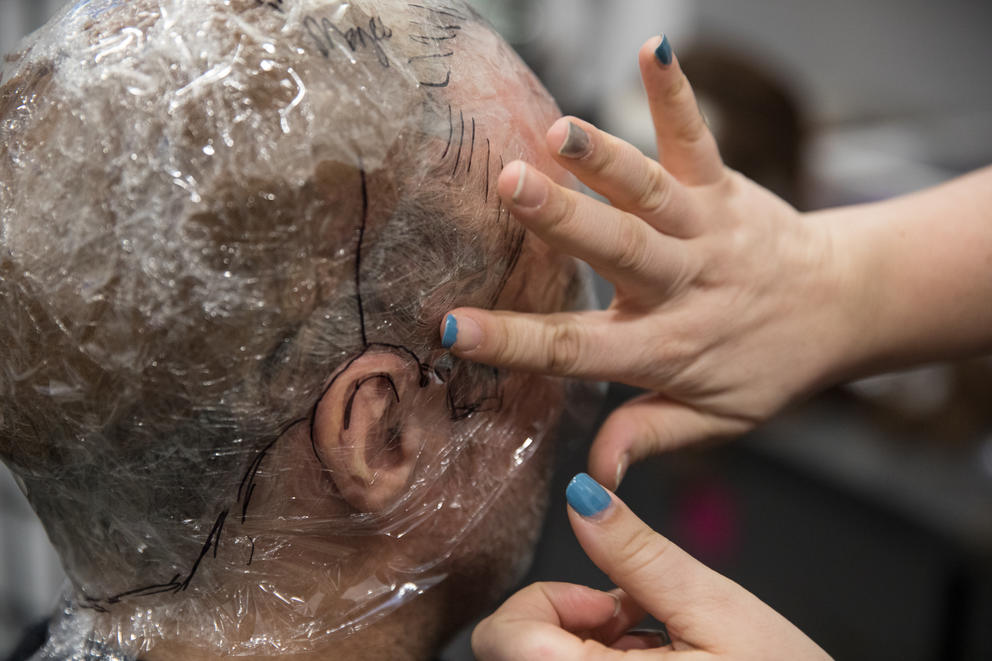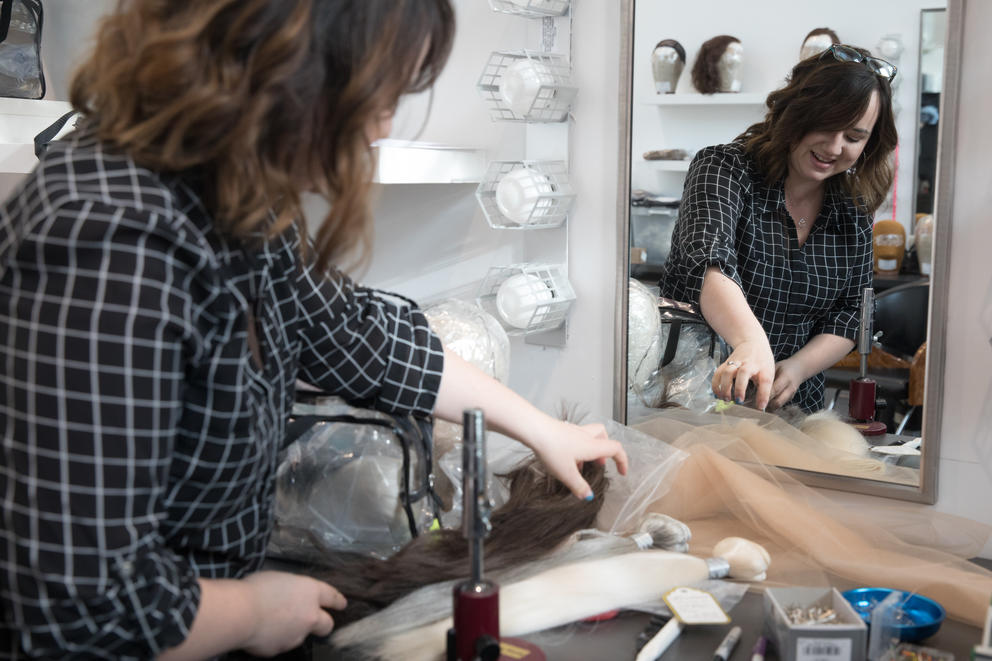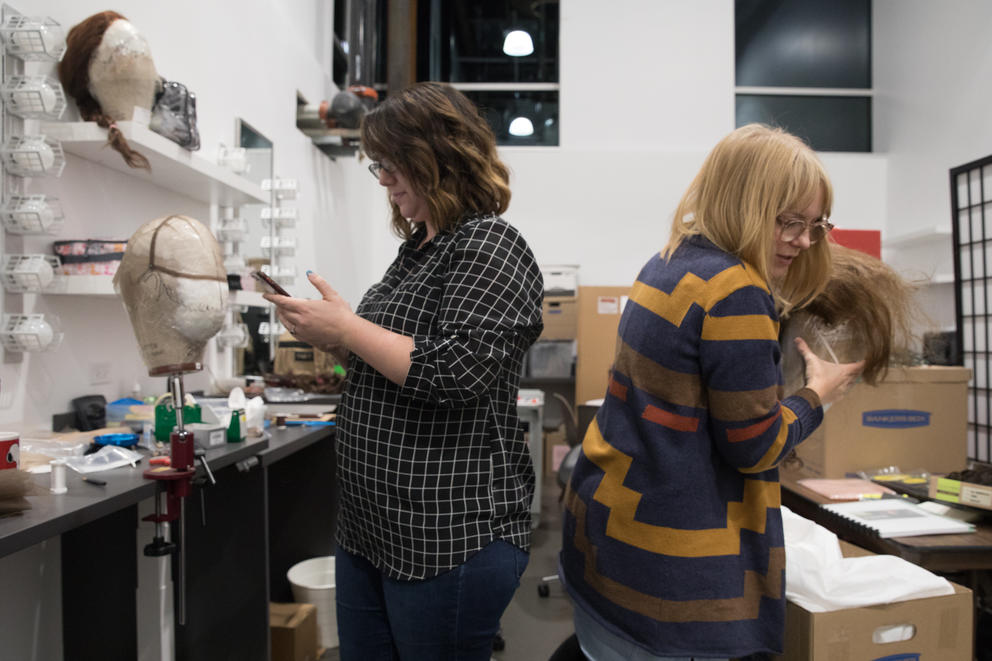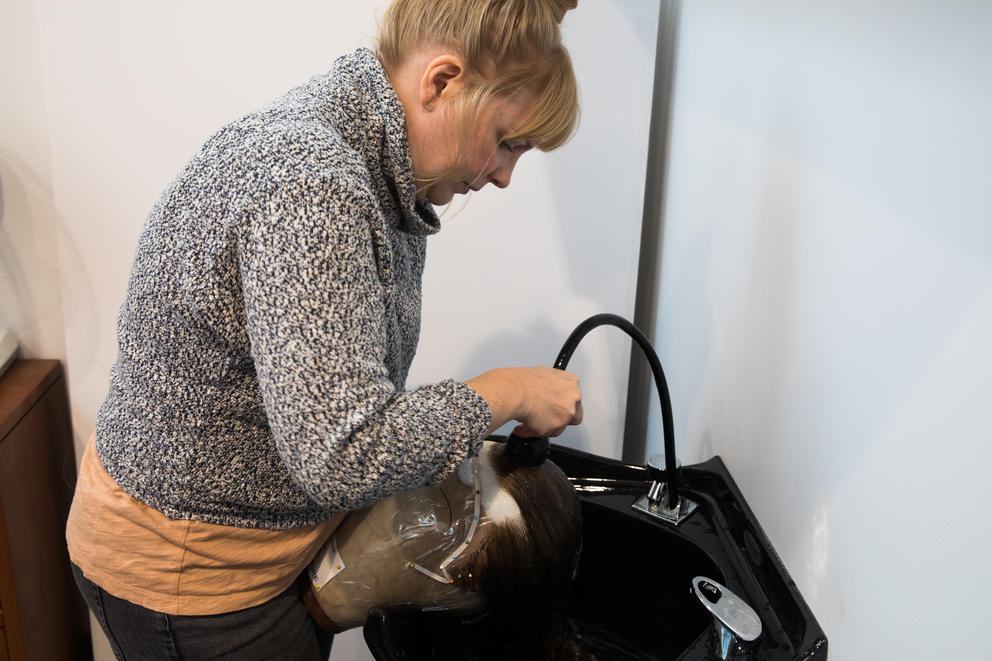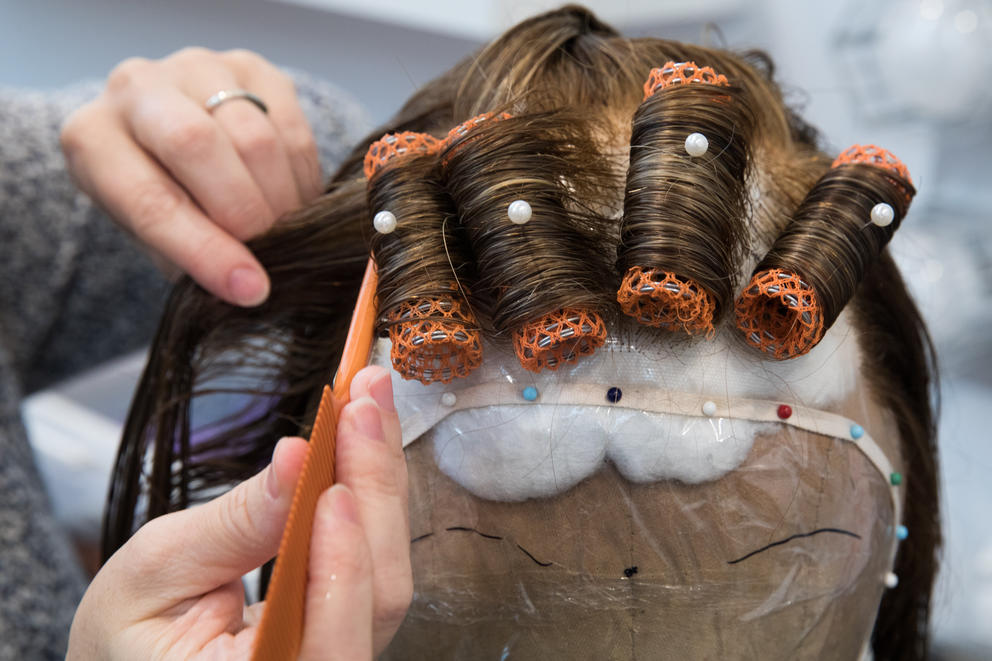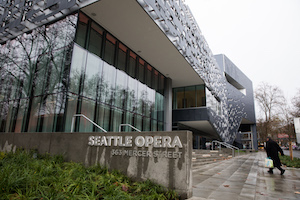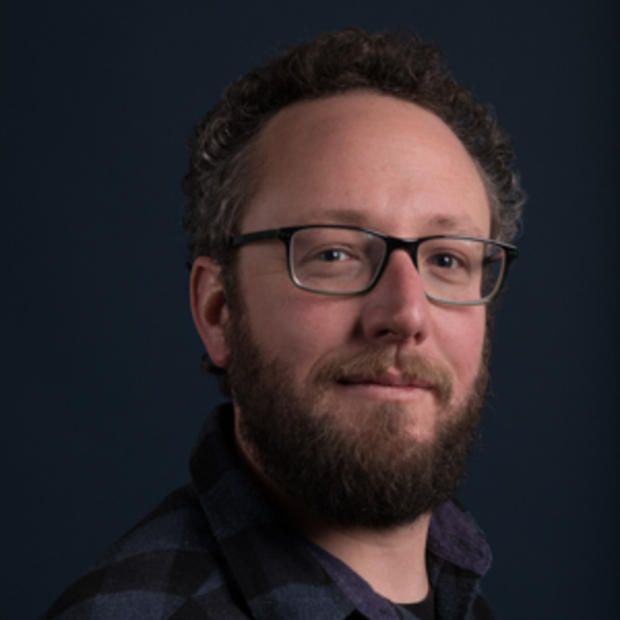The old building — a former carpet factory in South Lake Union that Seattle Opera had leased for staff, rehearsal space and storage since 1993 — was notoriously dark, cramped and labyrinthine. The hair and makeup department was lodged in a storage space at the end of a hallway. It had no door, just a plain curtain separating the windowless space from the freight elevator.
“It would be funny when someone came up [in the elevator] and the curtain wasn’t pulled,” recalls Seattle Opera hair and makeup manager Liesl Alice Gatcheco. “I’d say, ‘Hello and welcome!’ and they’d have a stunned look on their face.” With the new building, she says, “We’ve probably quadrupled our space.”
Now, the whole production department can breathe (and sew) easier. Technically located below ground, the space nonetheless feels bright and airy, thanks to natural light pouring in from the street-level windows running the length of the wide-open, high-ceiling room. Behind-the-scenes creation has suddenly become public, as anyone walking along Speight Jenkins Way can follow a new pathway adjacent to the building to see costume work in progress through the windows.
Seattle Opera performer Martin Muehle gets his head wrapped in cellophane by wig master Ashlee Naegle ahead of the upcoming production of Il trovatore. The wrap system is used to create custom wigs, which allow for greater comfort and security, time saved on performance nights and financial savings as the opera no longer needs to rent wigs.
During an advance tour of the building this week, the costume staff was already busy prepping for the next production, Giuseppe Verdi’s Il trovatore. One staffer at a wide counter snips camouflage fabric off a bolt, another perfects a delicate lace cuff. They’re surrounded by dress forms, barrels of fabric bolts, yellow bins full of boots, hats lining a shelf, endless spools of colored thread and stacked boxes labeled “Tassels,” “Fringe,” “Pompoms and Bows.”
At the southeast end of the space sits the newly christened wig workshop, easily identifiable by the rows of mannequin heads sporting wigs of various hairstyles. A tall window in the room frames the view of the Space Needle so perfectly, it’s as if it were a huge poster. Gatcheco shares the space with wig master Ashlee Naegle, who at the moment is making a clear plastic head mold of Il trovatore principal Lester Lynch (who plays Di Luna). He laughs in a way that can truly be described as operatic while the two women are, appropriately, wigging out about their new digs.
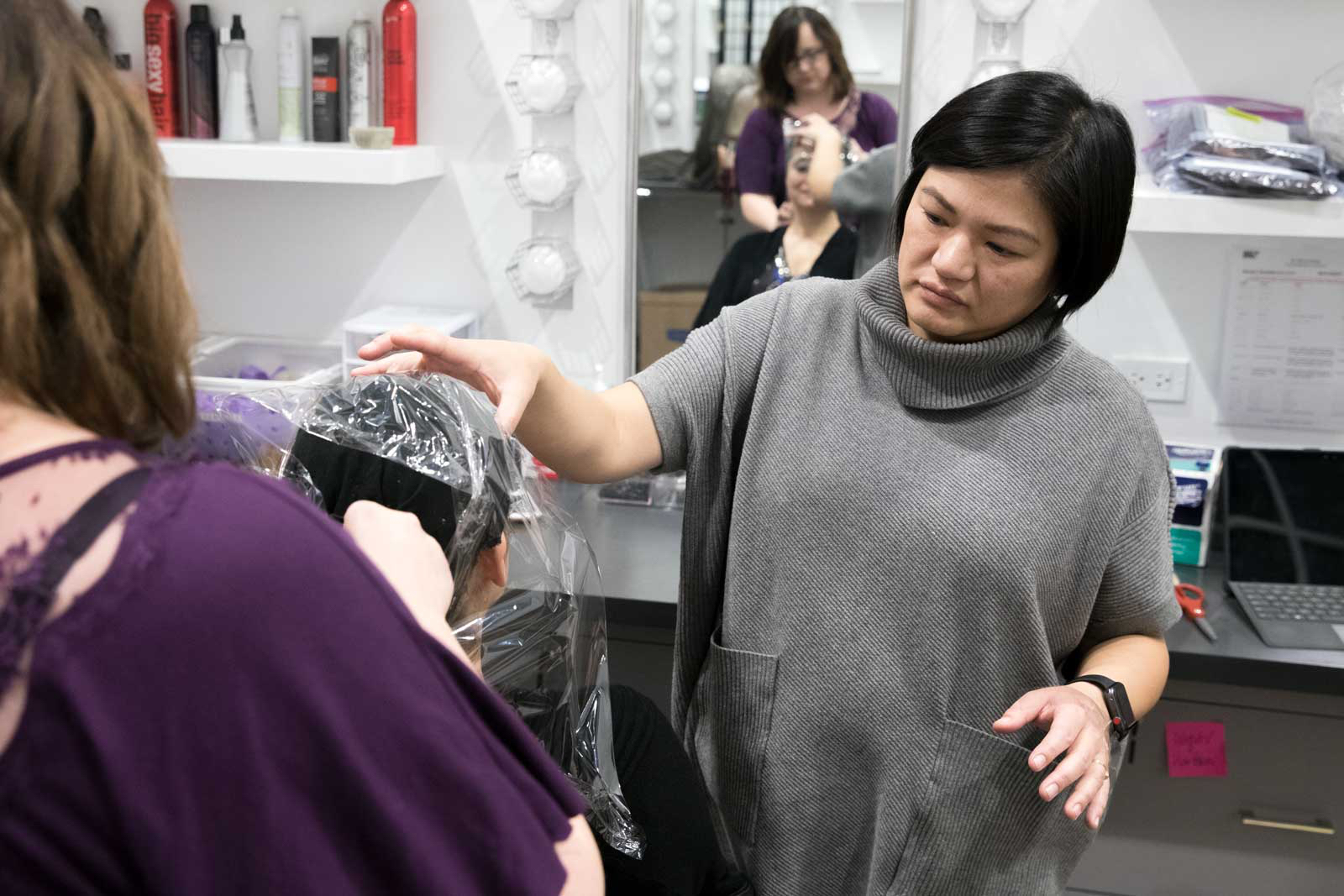
“It’s crazy!” Gatcheco says of the spacious new shop. She started working for Seattle Opera in 2003, as a stitcher in the costume department, and in 2007 moved to hair and makeup. “We were working out of a closet, literally,” she says of the old space. (You can see them jammed into their cinder-block nook in a Seattle Opera video featurette released last year.) “I fought for this new space,” Gatcheco says. “And now that we’re here, I’m having nightmares about having to go back. Actual nightmares.”
Now the wig shop has plenty of room for hand-building, fitting, styling and setting (thanks to a nifty new wig oven). “The amount of counter space!” Naegle adds. She joined Seattle Opera in 2007 as Gatcheco’s intern and became her full-time wig master last year. Both staffers say a big benefit of the space is the natural light, which helps tremendously in getting hair color correct. Next door, in the room where fabrics are dyed for costumes, dyer Miriam Goodman-Miller voices similar thanks; when she first saw the natural light in her new space, she says, “I almost wept.”
A high-caliber production space is especially important now, as the wig shop has embarked on a hairy new endeavor: hand-building all the wigs for every Seattle Opera production.
“Everyone you see on stage at Seattle Opera is wearing a wig. Everyone,” says Kristina Murti, director of marketing and communications. The reason is partly due to aesthetics (“If you have a big dramatic costume, regular hair makes your head look tiny,” says Gatcheco) and also maintaining the artistic director’s vision. But mostly, wigs save time. It would take much longer to style hair for an entire cast over multiple nights than it does to pop on a wig.

Prior to the 2017-18 season, the opera rented all its wigs, an unusual and costly custom. “Most theaters and opera companies build their own wigs,” says Gatcheco. “[Seattle Opera director] Aidan Lang and the previous CFO [chief financial officer] saw the numbers and were wondering why it had never been done before.”
With the new headquarters and expansive wig shop in their sights, the team got to work building a wig stock. They currently have about 100. Gatcheco’s goal is to have sets of wigs for every hair era, which would mean about 500 total. She says the company will save “several thousand dollars per show” by creating and storing wigs that can be re-used and modified for the 44-person chorus and visiting principals.
Each wig takes about 40 hours to make. Naegle begins by pinning up the performer’s natural hair so she can get an accurate mold of the head. Using cellophane and clear tape, she covers the scalp, ears and eyes. This “head wrap” process usually doesn’t take more than 15 minutes, but sometimes even this step can be challenging. “One guy had dreads down to his butt,” she recalls. “I had to wrap them around his head to fit a wig that looked like short 1940s hair.” As she talks, she carefully winds up the long black hair of Nora Sourouzian, one of two women who play Azucena.
Naegle then traces the performer’s natural hairline onto the plastic with a black Sharpie, so she’ll know where to tie on the wig hair (which arrives in long plastic bags that read “Human Hair”), and adds eyebrows for reference. Once removed, the mold looks a little like a transparent phrenology head. She pads the head wrap with cotton batting, places it on a wig block, covers it with netting (or “wig lace”) and begins the tedious process of tying the hair on via teeny tiny knots.
“Wigs are a dying art form,” says Gatcheco. “It’s hard to find people who make good wigs. And more and more directors are wanting to do modern shows with natural hair.” But, she says, new higher quality lighting technology means audiences can see more details, so expert wigs are even more important. Naegle says she always tries to share her knowledge with students in the field so the wig-making trade can continue.
As Il trovatore approaches, Gatcheco and Naegle are looking forward to the efficiencies of their new space. “Before, we’d have to pack up at South Lake Union, drive over to McCaw, pack out, then move it all back,” says Gatcheco. “There was a lot of trucking.” But mostly, the two friends — who have bonded over everything from shared Filipino heritage to food to Game of Thrones — are thrilled to have a roomy, light-filled new home where they can take the craft of wig making seriously. “It’s really a joy to watch Ashlee set up and work in this new, gorgeous space,” Gatcheco says, “and know that I had a hand in making her professional dream to be a wig master come true.”
Crosscut arts coverage is made possible with support from Shari D. Behnke.


